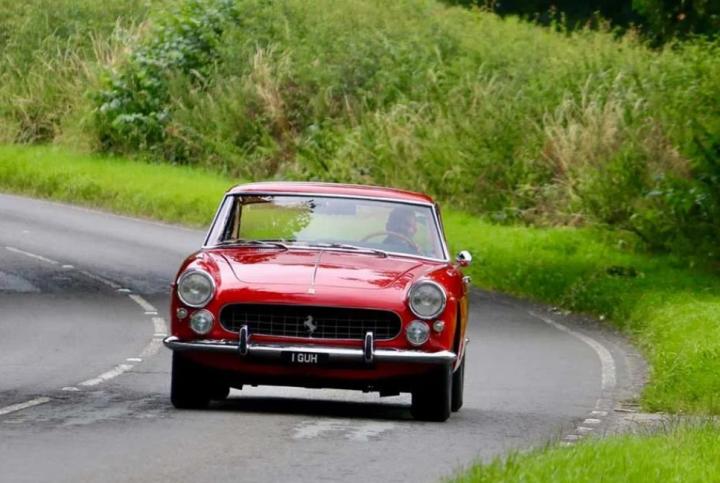Not to be confused with the America series that ran until 1967, The 330 America is the first
member of the 330 series. Prior to the 250GT/E being replaced by the 330GT, a strictly
limited run of 50 interim cars were built. The vehicle was described as a hybrid, combining
the looks of the 250 GT/E with the improved power and performance from the new kid on the block! It was the perfect combination. Completing the run of the most commercially
successful road-going car of the Prancing horse at the time, opening the automaker’s eyes to the 2+2 layout. Ranging from chassis numbers 4953 to 5125, making this an extremely
collectible model.
Named the 330 America, this model was essentially a series 3 GTE equipped with a 4litre
engine that would be later used in the 330GT. This engine brought with it a useful dose of
extra horsepower: 300bhp compared to the 235bhp from the outgoing three-litre unit.
A few historical snippets; The long wheelbase 250 GT theme was expanded in mid 1960 with the 2+2 model 250GT/E, this was the first large production four-seater Ferrari (earlier
models were made but in very small numbers). Interior space was increase by moving the
engine forward in the chassis to allow four adults to travel in comfort. By the time the
production drew to an end in late 1963, the 250GT/E was a best seller, nearly three times
more than Ferrari’s next best model the 250 GT Coupe, making this vehicle a major
contributor to their financial well-being during the 60’s. Another historical reference was
Tractor manufacture Ferruccio Lambourghini owned several 250’s, his final model being a
white 250GT/E; in his frustration with Enzo Ferrari’s replies to his complaints re frequent
clutch problems, turned out to be the key to his decision to make his own motorcars. He later hired ex-Ferrari engineers to design and develop them.
The 330 America has confused the motoring industry for many a year, as it was never
formally announced by the factory in a press conference or press release, never informally
lent out to an automotive magazine or newspapers for road test or drive, never even squeezed onto the back of a Ferrari stand at a motor show or salon, never even acknowledged with its own proper Ferrari factory brochure, the 330 American simply appeared out of nowhere in the last months of 1963 and was soon gone in a wisp, out of sight, and very soon out of mind, except for the 50 people who owned one. Rumour has it that Luigi Chinetti, insisted something was done to stop a draught in sales hence the name and the fact most of those built ended up in the USA.
Had Pininfarina finished the 330GT body would it even ever have existed?
1,000 bodyshells were supplied by Pinin farina; 950 Ferrari GT/E’s were built leaving the
remaining 50 to become the 330 America. All 50 models were built in left-hand drive only
and released prior to the GT/E’s successor, the larger 330 GT 2+2 making this model one of the rarest Ferrari Road cars. While it’s not known how many of these cars have survived, as some were used as donor vehicles to replicate the 250GTO and California, it is believed that only 25 remain in existence.
Exterior
Similar to the 250 GTE before it, the 330 America is stunning example of automotive artwork
on the outside, starting with chromed eggcrate grille at the front. Gifted with round
headlights, auxiliary driving lights, vertical taillights, and a quad-piped exhaust system. The
Pinin farina-styled gran turismo proudly wears a chrome-plated 330 America badge on the
lower right of the tailgate.
Interior
The luxuriously appointed cockpit is a mix of fine leather, carpet and chrome. It incorporates a body-coloured instrument panel upholstered with a padded black dash top and matching knee roll. Directly behind the wood-rimmed three-spoked steering wheel is a large read out for the engine revolutions and road speed with a small oil pressure gauge positioned in between. Five additional read gauges (oil temperature, water temperature, fuel, battery amps and clock) are housed in the centre of the dashboard.
Most of the switchgear is located on the centre console that links the dash to the transmission tunnel. Leather is used to cover the seats, transmission tunnel, door panels and sidewalls, while beautifully crafted chrome ashtrays are provided to both the front and the rear of the cabin.
With enough space to accommodate four adults in comfort, the 330 America had a few rivals.
Engine
The all-aluminium Tipo 209 B 60˚ V12 engine was fitted with triple weber 40DCL
carburettors, Ferrari had previously used a 4-litre engine on the 330LM and 400
SuperAmerica. However, the 209B was a modified version of the 209 to incorporated
numerous significant advances including a slightly longer block which allowed for wider
spaced cylinder bores and revised combustion chambers in the interest of better cooling and improved breathing. A single overhead camshaft per bank was employed along with two valves per cylinder, wet sump lubrication, single plug ignition and two coils.
Although the 330 engine was demonstratably superior than the 400 Super America, it was
never the less controversially rated at 300 brake horsepower, 40 hp fewer than its progenitor.
Given that it’s an early 1960’s grand tourer of Italian origin, it shouldn’t come as a surprise
that Ferrari didn’t provide an option for automatic transmission. They instead installed a fourspeed synchromesh gearbox with electronic overdrive on top and a Fichtel & Sachs singleplate clutch. At the rear of the vehicle a limited-slip differential supplied by ZF also needs to be highlighted.
Chassis
The 330 America used a GTE-spec Tipo 508 E chassis with a standard 2,600mm in the
wheelbase. The GTE chassis was unique among Ferrari frames of the era as the engine was positioned further forwards to free up additional cockpit space. The chassis itself was
fabricated from tubular steel. Multi-tubular chassis were similar to that of the Pinin farinadesigned 250GT ‘Notch Back’ coupe and 200mm longer than the contemporary 250 GT SWB’s. Moving the engine forward by 200mm and widening the rear track by 38mm made room for two rear sears in a bodyshell which, despite its increased length, retained
Pininfarina’s customary classical proportions. Independent front suspension with unequal length wishbones, coil springs and telescopic dampers. The rear of the vehicle used a live axle with radius arms, semi-elliptical springs, and more telescopic dampers.
Brakes
Dunlop Hydraulic disc brakes were fitted all round along with 6x15” Borrani wire wheels,
wrapped in the finest Pirrelli Cinturato 185VR15 tires.
A 90-Litre fuel tank was located underneath the boot floor.
It should be noted of course the 330 American’s are especially rare – rarer, in fact the most
production Ferrari’s of the period. Furthermore, they are particularly convenient and driverfriendly GT cars with plenty of V12 power to boot. In short, they combined the absolute best
characteristics, performance and collectability.
Top speed 150mph (240kph)
Power: 300bhp at 6,600rpm
Torque: 240lb-ft at 5,000rpm
0-60mph: 7 seconds
Weight: 1,310kg
Compression Ratio: 8.8:1
Chassis no. 5109GT 47/50
Imported in 1964 to by North American Ferrari Importer Luigi Chinetti Motors Inc, Luigi
was personally appointed as a Ferrari factory agent by Enzo Ferrari.
Build number 47 of 50, Chassis 5109GT
This vehicle was originally purchased in April 1964 with 103 miles on the odometer the list
price in 64 was $14,350 + tax and license, however the owner managed to strike a deal with a direct order through Sergio Pininfarina. The first owner was Mr. John R Bond of Bond
Publication, New York. Who used the vehicle at his personal residence in Newport Beach,
California Mr. Bond was known for his vigorous, strongly held, and often controversial
opinions, and for 40 years, he was one of the most important voices in American motoring
journalism. His 330 America was presented in Rosso Cina (20456S) exterior and Beige VM
(3218) interior, carrying the registration Number OMJ 464.
After establishing a secure financial footing for his magazine ‘Road & Track’, Mr. Bond as
conservative as he was, decided to splurge and order a new Ferrari. Originally Mr. Bond
ordered a 250 GT/E, however, during a visit to the factory to be shown the vehicle on the
assembly line, Enzo Ferrari personally showed both he & Mrs. Bond the vehicle and
informed them, that he had been upgraded to the 330 America that we present to you today.
During the ownership Mr. Bond often made occasional reference to this vehicle in his
magazine article entries ‘Miscellaneous Ramblings’. Stating it was a virtually trouble-free
vehicle mechanically and one of his few vehicles that could be left for a period of weeks and guaranteed to always start, he made reference to fuel economy over long drives.
He recalled one long trip in the car from Newport Beach to Phoenix and back in five hours
20 minutes. “I held almost 100mph most of the time,” he recalled, and “Still got almost
15mpg” cruising at 70-75mph yielded 17.5mpg. Sometimes went a month without starting it
“but when we came home from a trip it was often the only one of three cars in our home
garage which will start”
Following ownership of the vehicle for 11 years Mr. Bond, listed the Ferrari for sale in the
November of 1975 and purchased by Mr. Arthur Montgomery of Atlanta, Georgia. Mr.
Montgomery was a prominent executive at Coca-Cola and an avid automobile enthusiast. and in addition to this Ferrari, his stable also included such illustrious vehicles as a Duesenberg Model J.
Unfortunately, there is little history and information linked to a brief two-year
ownership.
After being advertised for sale by legendary racing driver Charlie Kemp’s International
Motorcars in 1978 the Mr. Bert Stanfield-Pinel to become the third owner of the vehicle,
during his ownership a number of maintenance tasks were completed and he would later be re-united with the vehicle to re-trim the vehicle, in 1981 the vehicle was listed for sale by
Gran Touring Cars inc and also by Harley Cluxton III in AutoWeek in August 1981 the
owner of the vehicle becoming good friend of Mr. Stanfield-Pinel, Mr. Robert ‘Bob’ Glenn
who used and enjoyed the vehicle for five years before listing and selling to the new owner.
November 1989 Mr. Howard V. Leendertsen, President of Hilton Oil Corporation, who’s
residence was in Bellevue, Washington, Becoming the next owner of this 330 America, with
just over 31,000 on the odometer, he owned the vehicle until 1998 before listing the vehicle
for sale.
In 98 the vehicle changed hands to Mr. Donald J. Roose of Bainbridge Island, Washington
who enjoyed ownership until 2005. During Mr. Roose’s ownership the Ferrari was prepared
to compete in historic racing events, to include the colour change from the original Rosso
Cina, to the shade of red the vehicle is presented to this date. In the file of documentation
supplied with the vehicle there are a large volume of invoices for repair, replacement parts
and trackside services during such events. The vehicle remained in Red, albeit now a more
commonly recognisable Ferrari red with yellow accents. The vehicle competed at various
events to include races at Monterey and Laguna Seca. The racing era for this vehicle was
only very brief and it’s documented that many of the original parts were removed and
replaced for racing items and retained to be re-installed upon the completion of it’s time as a racer.
Prior to the sale of the Ferrari Mr. Roose, removed the roll-cage and racing livery and
returned to a more road standard version.
Roose part exchanged the Ferrari in April 2005 to Mr. Andrew Flanigan, of Santa Barbara,
California for a Porsche 912 and cash payment. It was at this point mostly returned to its
original specifications, which included application of fresh paint and also re-trimmed by
Tappezzeria Luppi, the original Becker Europa radio and chrome wire wheels were also reunited to the vehicle, as well as the installation of RJS racing belts, which added a sporting touch to the parchment interior. The original 4-speed transmission was replaced and upgraded with a five-speed manual gated transmission. As a desirable upgrade.
The vehicle was listed for sale with RM Sotherby’s auctions where the current owner and our client, was the successful bidder in 2014, the vehicle was now registered in the UK, and resides in the North West of England under the registration number DHJ 614B, now wearing a cherished registration number (not included in the sale). During this time, it has been part of a private collection and used and enjoyed on tours and events with motor clubs across the United Kingdom.
Ramsport has looked after the vehicle since 2022, where various works have been
undertaken. Service and inspection to the vehicle, Tappet adjustment, replacement of the
electromagnetic water-pump fan and rebuild of the water-pump assembly, replacement of the brake master cylinder to the underside of the vehicle. And most recently a replacement
ignition switch which are prone to failure on the 250 series vehicles.
The 330 America is one of the rarest Ferrari’s of its era and examples are very seldom offered for sale, but unlike many, this particular vehicle has the added benefit of long-term enthusiast ownership by one of motoring’s most prominent and outspoken voices.
Viewing of the vehicle is strictly by appointment only, should you have any questions or wish to discuss and view this fantastic example, please do not hesitate to contact.





